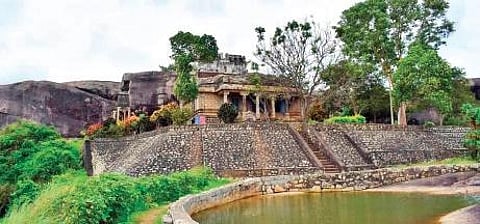

THIRUVANANTHAPURAM: Jainism, one of the oldest religions in the world, derives its name from a Sanskrit verb ‘Ji’ that means ‘victory’ or ‘to conquer.’ As the name suggests, religion definitely holds a throne when it comes to our history. Chitharal Malai Kovil, situated near Kuzhithurai in Kanyakumari district, is a chest that holds the glorious past of Jainism.
Chitharal Rock-Cut monument and Bhagavathi temple are situated atop a hillock named Thirucharanathumalai which is locally known as Chokkanthoongi Hills. Though history takes it back to at least the first century to the sixth century, the Jain shrine reached its zenith into a rock-cut temple during the reign of Vikramaditya Varaguna, an Ay king of 9th century, as per Tamil inscriptions in Vatteluttu script present in the monument.
Archaeologist and epigraphist T A Gopinatha Rao in his Travancore Archaeological Series has well-documented this site which was in a bad shape back then in 1920s. The site includes a rock-cut cave temple and a Bhagavathi temple with the remaining tower and a natural spring that never dried up. The cave temple has three sanctums namely for the last tirthankara Mahavira, 23rd tirthankara, Parsvanatha and his Yakshini goddess, Padmavati.
“The sculptures have Jain iconographies like the five-headed snake for Parsvanatha and the three-level umbrella for Mahavira that help us identify the figures easily,” says historian M G Sasibhooshan. Outside walls of the natural cavern have the reliefs of tirthankaras and other Jain icons.
“Goddess Padmavati had huge prominence in the shrine. It is common to pray before tirthankaras for spiritual and Yakshis for material aspects. Even Hindus considered the yakshini Goddess Padmavati sacred to them, which led to the emergence of a Bhagavathi temple around the 13th century in the southern side without affecting the Jain iconographies,” says Sasibhooshan.
“A tower was built later and when Gopinatha Rao visited around 1920s, there was already a Bhagavathi temple,” he adds. “Vadakkirikkal or Sallekhana which is a Jain practice to fast until death might have also been practised in this place. The temple was once a Jain centre where education was imparted to male and female Jains. It also had a strong connection with another important centre Kazhugumalai in Thoothukudi that could be seen in the inscriptions,” says Sasibhooshan.
The mentions of figures like Gunandagi kurattikal, a Jain nun, gives insight into the position of Jain women during that era. “The inscribed names of Uttanandhi, Achanandhi and Viranandhi who sculptured the carvings are very significant as it’s not that common to mention the name of sculptors in the region,” says Sasibhooshan.
This place, mentioned in C V Raman Pillai’s ‘Dharmaraja,’ has been a Centrally-protected monument now maintained by Thrissur Circle of Archaeological Survey of India since 1964. Chitharal Malai Kovil is definitely an archaeological marvel that etches the immense influence Jainism had on our history and culture.
There & Then
Weekly column on historic, iconic places in the city. Send suggestions to cityexpresskoc@newindianexpress.com